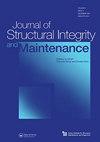Examining changes in bridge frequency due to damage using the contact-point response of a passing vehicle
IF 3.1
Q2 ENGINEERING, CIVIL
Journal of Structural Integrity and Maintenance
Pub Date : 2021-07-03
DOI:10.1080/24705314.2021.1906088
引用次数: 31
Abstract
ABSTRACT Ongoing inspection and maintenance of bridges poses a challenging task for infrastructure owners who must manage large bridge stocks with limited budgets. Drive-by monitoring approaches, using sensors in a vehicle, provide a promising solution to this challenge. This paper investigates the use of the response at the point-of-contact between the tyre and the bridge as a means of monitoring bridge frequency. An expression is derived to allow the contact-point (CP) response to be inferred directly from in-vehicle measurements, expanding on previous studies by allowing the vehicle suspension characteristics to be considered. The sensitivity of the CP-response to the pavement characteristics is investigated in detail and a rigid-disk model is used to overcome issues with how existing vehicle-bridge interaction models consider the interaction between the wheel and the pavement. The feasibility of the CP-response as a measure of bridge condition is investigated and results show that the CP-response significantly outperforms the response measured directly on the vehicle. The CP-response is successful in identifying the bridge frequency and changes caused by damage, without being influenced by the vehicle frequencies. Incorporating the CP-response into drive-by bridge monitoring will improve accuracy over existing methods which use the vehicle response alone.使用过往车辆的接触点响应检测因损坏而引起的桥梁频率变化
桥梁的持续检查和维护对基础设施所有者来说是一项具有挑战性的任务,他们必须在有限的预算下管理大量的桥梁库存。在车辆中使用传感器的行车监控方法为这一挑战提供了一个有希望的解决方案。本文研究了使用轮胎和桥梁之间的接触点的响应作为监测桥梁频率的手段。推导了一个表达式,允许直接从车内测量推断接触点(CP)响应,扩展了先前的研究,允许考虑车辆悬架特性。详细研究了车轮-桥梁响应对路面特性的敏感性,并采用了一个刚性盘模型来克服现有的车-桥相互作用模型如何考虑车轮与路面之间的相互作用的问题。研究了cp响应作为桥梁状态度量的可行性,结果表明cp响应明显优于直接在车辆上测量的响应。cp响应在不受车辆频率影响的情况下,成功地识别了桥梁频率和损坏引起的变化。与仅使用车辆响应的现有方法相比,将车辆响应纳入行车桥监测将提高准确性。
本文章由计算机程序翻译,如有差异,请以英文原文为准。
求助全文
约1分钟内获得全文
求助全文
来源期刊

Journal of Structural Integrity and Maintenance
ENGINEERING, CIVIL-
CiteScore
3.90
自引率
9.50%
发文量
24
 求助内容:
求助内容: 应助结果提醒方式:
应助结果提醒方式:


